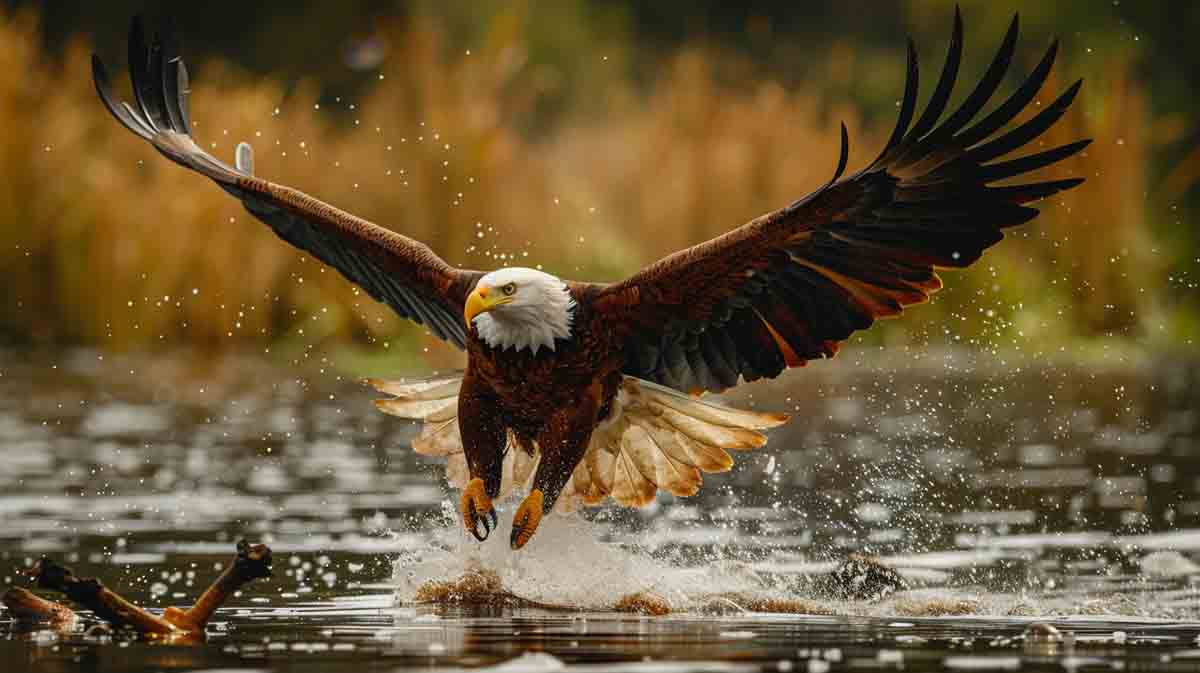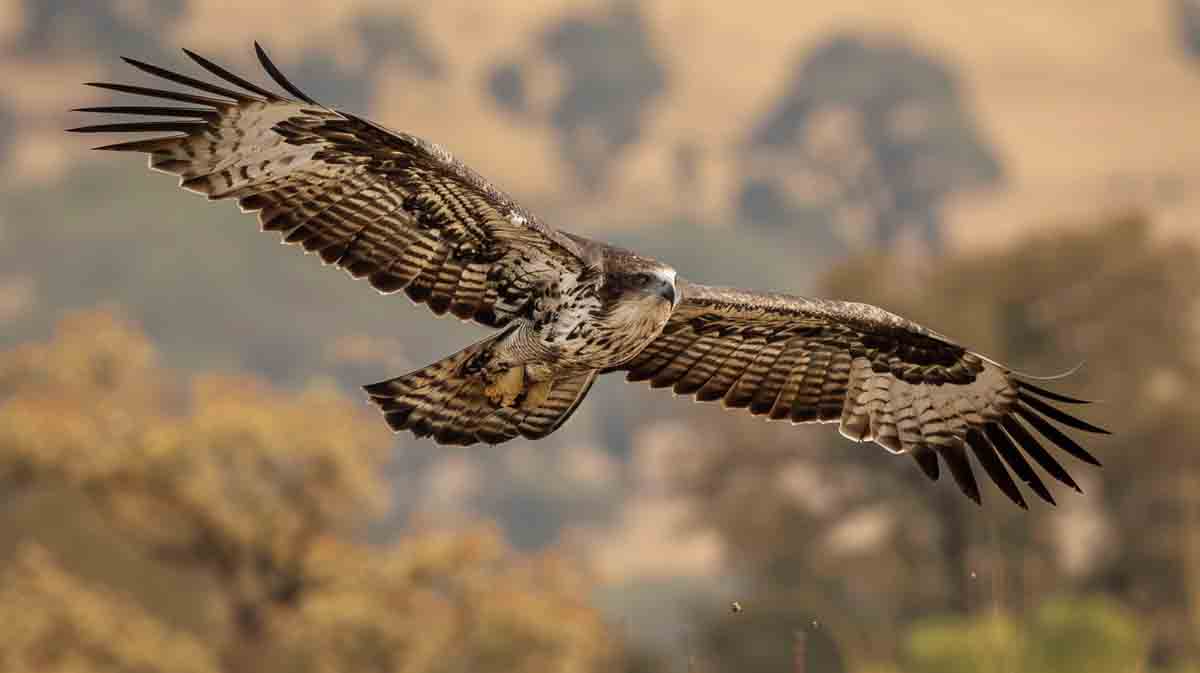Did you know that the world’s largest eagle has a wingspan reaching up to 7.5 feet?
Eagles are revered as one of nature’s most majestic creatures, with their fierce beauty and impressive hunting abilities. Among the various eagle species, one stands above the rest, both in size and awe-inspiring presence. This article will explore the world’s largest eagle, its characteristics, habitat, hunting techniques, and the importance of its conservation.

Key Takeaways:
- The world’s most giant eagle has a wingspan reaching up to 7.5 feet.
- Eagles are considered majestic creatures due to their beauty and hunting abilities.
- There are different species of eagles, each with its size and distinctive features.
- The giant eagle is known for its impressive physical attributes and hunting prowess.
- Conservation efforts are crucial to protect the habitat and populations of the largest eagle species.
What are the characteristics of the world’s most giant eagle?
The world’s largest eagle is known for its impressive physical attributes and distinct features. Let’s explore the key characteristics that make it stand out among other eagle species.
Overview of the physical attributes of the largest eagle
The largest eagle is renowned for its size, weight, and unique body features. It is considered one of the largest birds of prey in the world. With a massive wingspan and a muscular build, it commands attention in its natural habitat.
Comparison of the wingspan of different eagle species
When comparing eagle species, the wingspan of the largest eagle is genuinely remarkable. It surpasses that of many other eagle species, making it an awe-inspiring sight in the sky. The size of its wingspan is vital in its hunting abilities and overall survival in the wild.
Distinctive features of the Harpy Eagle
Among the various eagle species, the Harpy eagle deserves special mention for its distinctive features. With its imposing size, powerful talons, and striking facial appearance, the Harpy eagle is often regarded as a symbol of power and strength in nature. Its size sets it apart as one of the largest eagle species in the world.

Where are the largest eagles found?
Regarding the habitat and geographical distribution of the largest eagles, there are a few notable species to consider. One such species is the Philippine eagle, which has specific preferences for its habitat. The Philippine eagle is found in the lush forests of the Philippines, particularly in the islands of Luzon, Samar, Leyte, and Mindanao. These eagles thrive in these habitats, providing them with the necessary cover and resources for survival.
The geographical distribution of the Philippine eagle is limited to the Philippines, making it an endemic species to this region. Unfortunately, due to habitat loss and hunting, the population of the Philippine eagle is declining, making their conservation efforts crucial to their survival. Protecting their habitat is of utmost importance to ensure the continuation of their species.
Another noteworthy species is the Sea Eagle, known for its unique traits and hunting abilities. As the name suggests, sea eagles have a strong affinity for coastal regions and bodies of water. They are commonly found near coastlines and estuaries, where they can exploit abundant marine life for sustenance. These habitats provide the Sea Eagle with ample opportunities for hunting and nesting.
Lastly, the White-tailed Eagle has a specific habitat preference and a wide distribution range. They are commonly found near coastal areas, rocky shorelines, and wetland regions. White-tailed eagles are known for associating with these habitats, relying on them for food sources, nesting sites, and protection. Ensuring the preservation of these habitats is essential for the survival and population recovery of the White-tailed Eagle.
Preserving the habitats of these largest eagles is crucial for their conservation and the overall protection of their respective populations. Protecting these habitats will benefit the eagles themselves and contribute to the preservation of the diverse ecosystems that they are a part of.
How does the world’s largest eagle hunt and feed?
The world’s most significant eagles employ various hunting techniques and exhibit diverse prey preferences and feeding habits. This section explores the Golden eagle’s hunting behaviour, the Martial eagle’s prey preferences, and the Bald eagle’s feeding habits.
Insight into the hunting behaviour of the Golden Eagle
The Golden Eagle is an apex predator known for its exceptional hunting skills. It employs a combination of stealth, speed, and power to capture its prey. With a keen eyesight, it soars high above its territory, scanning the landscape for potential targets. Once a prey is spotted, the Golden eagle swoops down with great precision, using its sharp talons to grasp and immobilize its victim. The golden eagle primarily preys on small mammals, such as rabbits, ground squirrels, and birds.

Prey preferences of the Martial Eagle
The Martial Eagle is one of the largest and most powerful eagles, renowned for its predatory prowess. Its formidable build and strong talons enable it to tackle a diverse range of prey. The Martial eagle predominantly preys on small to medium-sized mammals, including hyraxes, monkeys, and birds like guinea fowl and francolins. It uses an ambush strategy, perching atop large trees or rocks and swiftly descending upon unsuspecting prey. The Martial eagle’s hunting behaviour showcases its agility and adaptability as an apex predator.

Feeding habits of the Bald Eagle
The Bald Eagle, an iconic symbol of the United States, exhibits unique feeding habits primarily focused on its diet of fish. With its immense wingspan and sharp eyesight, the Bald eagle soars above water bodies in search of fish near the surface. Once it spots a suitable target, the bald eagle swoops down, extending its sharp talons to snatch the fish from the water. The bald eagle is known to scavenge and opportunistically feed on carrion. It also displays a behaviour known as kleptoparasitism, where it steals prey from other birds, particularly smaller eagles and ospreys.

What are the conservation efforts for the largest eagles?
Various initiatives have been implemented to save the endangered Philippine eagle, including conservation and increasing its population. This includes preserving its habitat and protecting itious threats.
- Conservation measures for the Harpy eagle population have been implemented to protect this majestic bird from habitat loss and other environmental challenges. Efforts are focused on preserving the harpy eagle’s habitat and promoting its survival through research, education, and community involvement.
- The conservation of the White-tailed eagle poses several challenges, but significant efforts have been made to safeguard its population and promote recovery. These efforts include habitat protection, active monitoring, and conservation programs to mitigate threats to its survival.
The white-tailed eagle’s conservation success stories testify to the effectiveness of conservation measures and provide valuable lessons for future preservation efforts. By addressing the critical challenges faced by the largest eagles, such as habitat loss and population decline, conservationists can ensure the long-term survival of these magnificent birds and contribute to preserving biodiversity.
How does the largest eagle contribute to its ecosystem?
Eagles, as the largest avian predators, play a crucial role in maintaining the balance of their respective ecosystems. As top predators, they exert control over prey populations, preventing overpopulation and preserving the ecosystem’s overall health. These majestic creatures contribute immensely to their habitats through their hunting behaviours and ecological impact.
By preying on smaller mammals, birds, and even fish, the largest eagles help regulate the population sizes of their prey species. This predation pressure ensures that prey populations are not too abundant, which could lead to resource depletion or an imbalance in the food chain. As a result, the presence of these eagles helps to sustain healthy prey populations and maintain the biodiversity of their habitats.
The ecological significance of the largest eagles extends beyond population control. Their interdependency with their habitat is crucial for their survival. Their habitats provide critical resources such as food, shelter, and nesting sites. The availability of suitable prey and nesting areas is essential for these magnificent birds’ survival and successful reproduction. Protecting and restoring their habitats is crucial for ensuring the long-term survival of the largest eagles.

In conclusion, the largest eagles, as top predators, are vital in their ecosystems. Their predation behaviours contribute to maintaining ecological balance by regulating prey populations. Additionally, their interdependency with their habitat reinforces the need for habitat conservation to support these majestic birds. Recognizing the importance of the largest eagles in their respective ecosystems is crucial for their conservation and preserving the overall health of their habitats.
FAQ
What is the largest eagle in the world?
The largest eagle in the world is the Philippine eagle, also known as the monkey-eating eagle.
How does the size of the Philippine eagle compare to other eagle species?
The Philippine eagle is considered the largest eagle in the world in terms of length and wing surface. Its average wingspan is about 6.9 feet (2.1 meters).
What are some other notable species of large eagles?
Other notable large eagles include:
- The Steller’s sea eagle.
- The African crowned eagle.
- The American bald eagle.
- The wedge-tailed eagle.
What is the wingspan of the Steller’s sea eagle?
The Steller’s sea eagle has one of the most enormous wingspans among eagle species, with an average wingspan of 6.9 to 8.9 feet (2.1 to 2.7 meters).
Is the American bald eagle the largest eagle in the world?
While the American bald eagle is a well-known symbol, it is not the largest eagle in the world. However, it is the national bird of the United States.
What is the size and weight of the African crowned eagle?
The African crowned eagle is a large bird of prey that can reach around 3.3 feet (1 meter) and weigh up to 14 pounds (6.5 kilograms).
Are eagles considered one of the most powerful birds in the world?
Yes, eagles are considered one of the most powerful birds in the world due to their impressive size, strength, and hunting abilities.
What is the significance of the sea eagle species?
Sea eagles, including the Steller’s sea eagle and the white-tailed sea eagle, are known for their large size and are considered some of the largest eagles in the world.
Are there any notable extinct species of giant eagles?
Haast’s eagle from New Zealand and Verreaux’s eagle from Africa were notable large eagle species that are now extinct.
Where do eagles primarily live and thrive?
Depending on the species, eagles usually live and thrive in various habitats, such as mountains, forests, and coastal regions.
